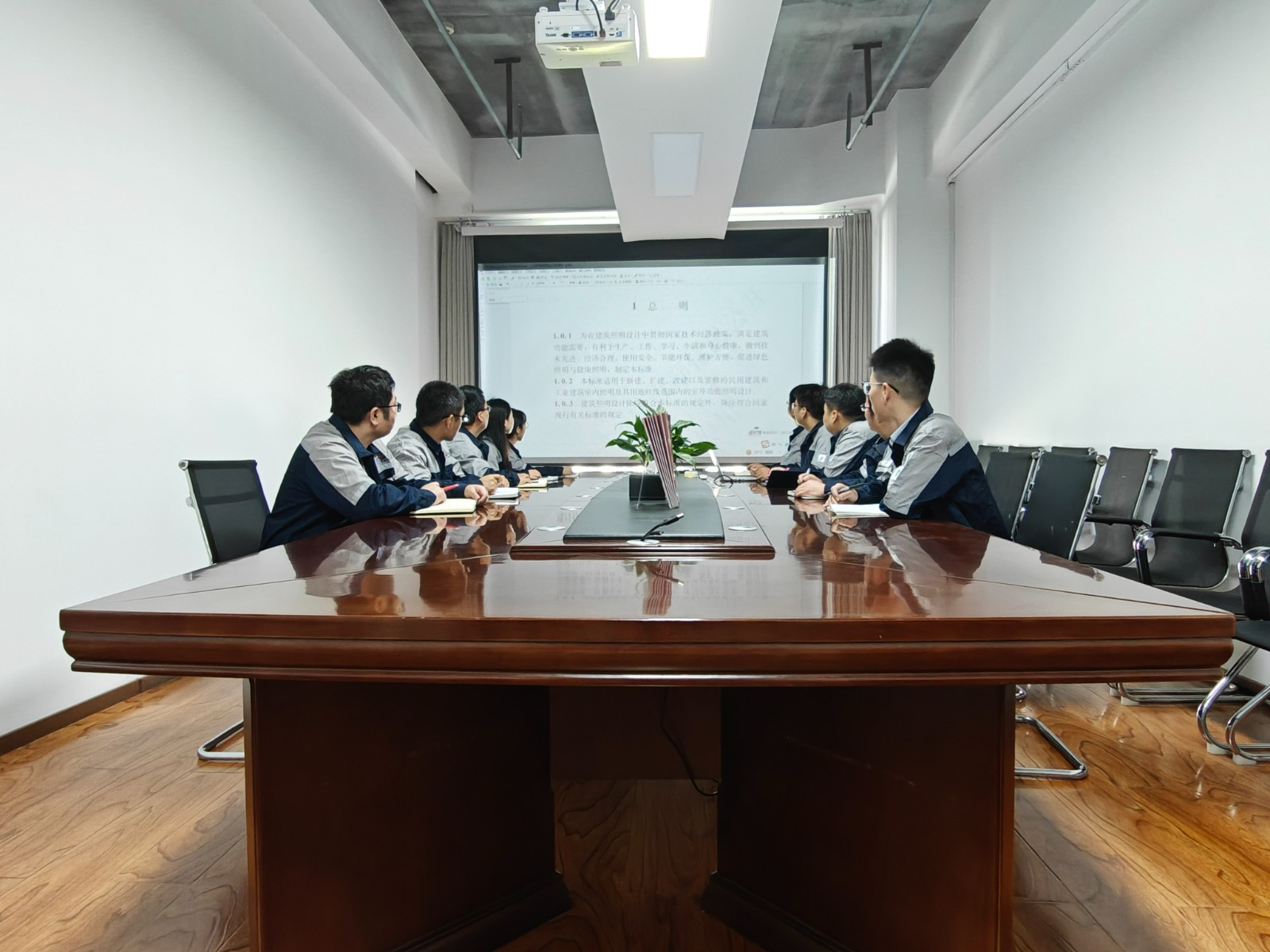Huafei Engineering Luoyang Branch Hosts Special Seminar on Architectural Lighting Design Standard (GB/T 50034)
Recently, the Ministry of Housing and Urban-Rural Development (MOHURD) of the People's Republic of China issued Architectural Lighting Design Standard (GB/T 50034) as a national standard. This specification is a recommended engineering construction code. Our Hebei Huafei Engineering Design Co., Ltd. Luoyang Branch (hereinafter referred to as "Huafei Engineering Luoyang Branch") Electrical Department, in response to the new regulation, took the lead in organizing a special seminar. Key discussion points are as follows:
 Photo Workshop Site
Photo Workshop Site
Main Contents of the Standard
This updated standard applies to indoor lighting design for all types of new construction, expansion, and renovation projects involving industrial and civil buildings, as well as outdoor functional lighting design within the red line boundaries (property limits).
The primary technical requirements of the specifications have been revised.
1. Added assessment metrics for non-visual effects (e.g., light's impact on circadian rhythms and mood), requiring adjustments to color temperature and luminance distribution based on space requirements to enhance the physiological and psychological health benefits of the lighting environment.
2. Strengthened photobiological safety requirements, limiting flicker effects (flicker visibility ≤1.3) and stroboscopic effects (flicker index ≤1) to reduce adverse impacts on eyes and the nervous system.
3.Clarified the definition of "healthy lighting", encompassing multidimensional requirements such as visual comfort, light quality (color temperature, color rendering), and spectral characteristics.
4.Explicitly designated LED as the main light source, specified its performance metrics, and categorized management for directional and non-directional LED lamps.
5.Added technical requirements for LED driver power supplies, emphasizing electromagnetic compatibility (e.g., avoiding electromagnetic interference in weak current rooms).
6.Introduced DC power distribution technology, supporting low-voltage DC supply to enhance safety and solar energy utilization.
7.Specified a 20% higher design illuminance ratio than standard values (old version allowed ±10%), with zero negative deviation permitted to ensure minimum illuminance compliance.
 Photo Workshop Site
Photo Workshop Site
Points to Note During Implementation
When implementing the standards, key priorities include: Embedding the concept of healthy lighting; Balancing illuminance levels with energy efficiency targets; Ensuring power distribution system compatibility; Aligning with other mandatory regulations. For designing, it is recommended to integrate intelligent control systems (e.g., KEEY iS System) and high-quality LED light sources. This approach not only meets the updated standards but also enhances the user experience of healthy lighting—guaranteeing compliance throughout all phases: design, construction, acceptance, operation, and maintenance.
1. Changes in Standard Nature and Scope of Application
(1).The new version of the standard has been downgraded from a mandatory national standard to a recommended one. However, certain clauses still require compliance with other mandatory regulations (e.g., GB 50016 Code for Fire Protection Design of Buildings and GB 55024 General Code for Building Electrical and Intelligent Systems), and designers must consider them comprehensively."
(2).New provisions have been added regarding healthy lighting, non-visual effects, and intelligent control systems, while lighting standards for different scenarios have been further refined."
2.Healthy Lighting and Non-Visual Effects
(1). The standard explicitly emphasizes the significance of non-visual effects (e.g., the impact of light on human circadian rhythms) for the first time, mandating that indoor spaces with prolonged occupancy prioritize intelligent control systems capable of adjusting both color temperature and brightness.
(2). A new definition of "healthy lighting" is introduced, underscoring the need to balance safety, visual comfort, and physiological rhythm regulation while mitigating adverse effects such as flicker and stroboscopic phenomena.
3.Energy Efficiency and Power Distribution System Optimization
(1). For power distribution system adjustments, LED driver power supplies must be categorized into isolated and non-isolated types. Grounding system selection: TT systems with 30mA RCD protection are recommended for streetlights and similar applications; when centralized power supply is impractical, TN-S systems may be adopted, but the power supply radius must be strictly controlled.
(2). The allowable voltage deviation has been relaxed from the previous ±10% to +20%. Designers should account for voltage fluctuations' impact on lamp lifespan.
4.Implementation During Transition Period and Conflict Resolution
(1). The 2013 edition of the standard will be repealed on August 1, 2024. New projects must comply with the new edition, while renovation of existing projects may refer to the new standard for optimization.
(2). Some newly added clauses overlap or conflict with the old standard (e.g., Clause 3.2.5 vs. Clause 3.3.5). In such cases, the more stringent or higher-standard requirements shall prevail.
The issuance of these new regulations marks a significant milestone in China's building lighting standards, ushering in a more scientific and practical era that will substantially elevate the level of healthy lighting in architectural design. The cross-disciplinary discussions among our professionals have greatly enhanced the technical expertise of our design teams. This seminar serves as a catalyst for elevating our company's overall design capabilities, injecting new momentum into our accelerated growth.


